For decades, SPAM has been a pantry staple worldwide, but the garlic-flavored version brings a distinctive twist to this classic product. Whether you're a longtime SPAM enthusiast or curious about this specific variant, understanding what makes garlic SPAM unique—and how to use it effectively in your cooking—can transform your meal planning.
What Exactly Is Garlic SPAM?
Garlic SPAM represents one of the most popular specialty flavors in the SPAM product line, joining other variants like Hickory Smoke and Hot & Spicy. This version contains the same base ingredients as traditional SPAM—pork with ham meat, salt, water, potato starch, sugar, and sodium nitrite—but adds garlic powder and other seasonings to create its signature flavor profile.
Unlike regular SPAM which has a relatively neutral savory taste, garlic SPAM delivers an immediate aromatic punch that enhances many dishes without requiring additional garlic preparation. The garlic flavor permeates the entire product, creating a consistent taste experience in every slice.

How Garlic SPAM Differs From Regular SPAM
| Feature | Garlic SPAM | Regular SPAM |
|---|---|---|
| Primary Flavor Profile | Distinct garlic-forward taste | Neutral savory pork flavor |
| Key Additional Ingredients | Garlic powder, natural flavors | None |
| Nutritional Difference | Slightly higher sodium content | Standard sodium level |
| Best Culinary Applications | Stir-fries, sandwiches, rice dishes | General purpose cooking |
Product Evolution Timeline
The introduction of flavored SPAM variants represents an interesting evolution in this classic American product. According to Hormel Foods' historical records, the timeline of SPAM's flavor development shows strategic expansion to meet changing consumer preferences:
- 1937: Original SPAM introduced during the Great Depression as an affordable protein source
- 1940s: SPAM becomes crucial military ration during World War II, establishing global presence
- 1992: Hormel introduces the first specialty flavor—SPAM Lite (reduced fat version)
- 2000s: Expansion of specialty flavors including Hickory Smoke and Hot & Spicy
- 2010: Garlic SPAM officially joins the product line in response to consumer demand for more flavor variety
- Present: Garlic SPAM remains one of the top three best-selling specialty flavors globally
Nutritional Profile and Dietary Considerations
Understanding the nutritional content of garlic SPAM helps you incorporate it wisely into your meal planning. A standard 2-ounce serving (about 3 slices) contains:
- 190 calories
- 16g total fat (6g saturated)
- 810mg sodium (35% of daily value)
- 13g protein
- 0g carbohydrates
Compared to regular SPAM, the garlic variety contains approximately 50-70mg more sodium per serving to accommodate the additional seasonings. While not considered a health food, garlic SPAM does provide complete protein and contains no artificial preservatives beyond the necessary sodium nitrite for preservation.
For those monitoring sodium intake, rinsing sliced garlic SPAM under cold water before cooking can reduce surface sodium by up to 30%, according to research published by the American Heart Association. This simple technique maintains flavor while making the product somewhat more suitable for those watching their salt consumption.
Practical Cooking Applications
The beauty of garlic SPAM lies in its versatility. Professional chefs and home cooks alike appreciate how this product simplifies meal preparation while delivering consistent flavor. Here are three practical ways to incorporate garlic SPAM into your cooking:
1. Quick Garlic SPAM Fried Rice
Cube 4 ounces of garlic SPAM and pan-fry until golden brown. Remove from pan, then scramble 2 eggs in the same pan with the rendered fat. Add 2 cups cooked rice, the SPAM cubes, frozen peas, and carrots. The garlic flavor from the SPAM eliminates the need for additional garlic, creating a complete one-pan meal in under 15 minutes.
2. Hawaiian-Style Garlic SPAM Musubi
A popular adaptation of the traditional Spam musubi, this version uses the garlic flavor to enhance the umami profile. Slice garlic SPAM thinly, pan-fry until crispy, then place on seasoned rice blocks wrapped with nori. The garlic notes complement the sweet-savory teriyaki sauce traditionally used in this dish.
3. Garlic SPAM and Vegetable Stir-Fry
Cube garlic SPAM and stir-fry with broccoli, bell peppers, and snap peas. The rendered fat from the SPAM creates an instant garlic-infused cooking oil that flavors the entire dish. Add a simple sauce of soy sauce, rice vinegar, and a touch of honey for a complete meal that requires no additional garlic preparation.
Where to Find Garlic SPAM and Storage Tips
Garlic SPAM enjoys widespread availability across the United States and internationally. Major grocery chains like Walmart, Target, and Kroger typically stock it in the canned meat section alongside other SPAM varieties. Internationally, it's particularly popular in Hawaii, South Korea, and the Philippines, where SPAM has become integrated into local culinary traditions.
When purchasing, check the "best by" date on the bottom of the can. Unopened cans maintain quality for 2-3 years when stored in a cool, dry place. Once opened, transfer unused portions to an airtight container and refrigerate—consumed within 7-10 days for best quality. For longer storage, sliced portions freeze well for up to 2 months.
Regional Popularity and Culinary Adaptation
Garlic SPAM demonstrates interesting regional variations in popularity and usage. According to market research from Nielsen, this variant shows particularly strong sales in:
- Hawaii: Where SPAM has been a cultural staple since World War II, with garlic SPAM commonly used in breakfast dishes
- South Korea: Incorporated into budae jjigae ("army stew") and other fusion dishes
- Philippines: Featured in garlic SPAM fried rice and as a sandwich filling
- United States mainland: Most popular in Western states with significant Asian-American populations
This regional variation highlights how a simple product adaptation can resonate differently across culinary cultures. In Asian markets particularly, garlic SPAM has found a natural home given the cultural importance of garlic in many traditional dishes.











 浙公网安备
33010002000092号
浙公网安备
33010002000092号 浙B2-20120091-4
浙B2-20120091-4